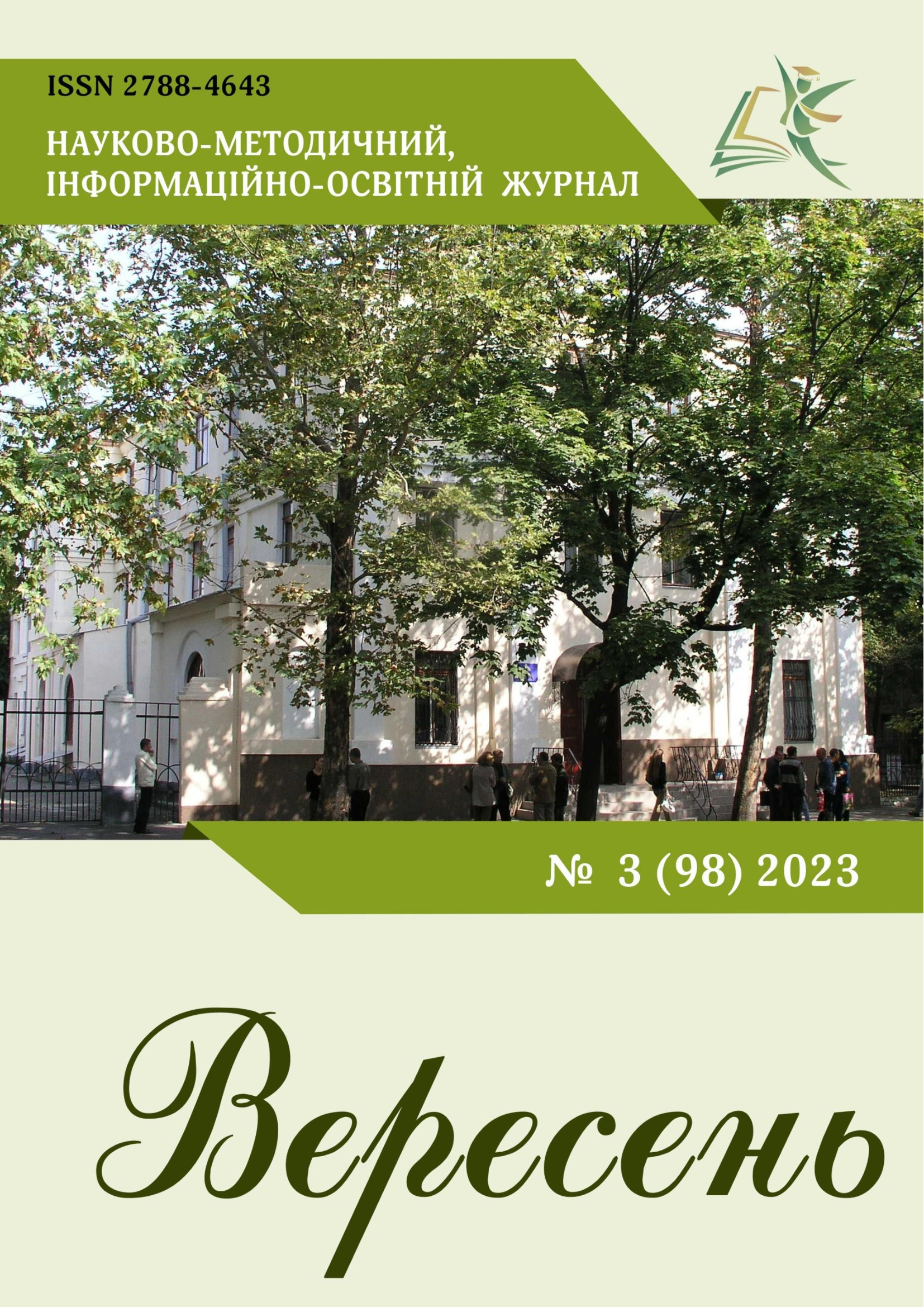DESIGNING A TECHNOLOGY MAP AS A PRODUCTIVE MODEL FOR AN ACTIVITY-BASED LESSON
DOI:
https://doi.org/10.54662/veresen.3.2023.02Keywords:
activity lesson, constructivist approach, designing, model, synergy, technological map, technologiesAbstract
This article examines the concept of a technological map of a lesson as an effective tool for teacher preparation. The use of technological maps aligns with the principles of the New Ukrainian School and enables the creation of productive activity-based lessons that meet the requirements of the State Educational Standard. The article analyzes the components of a technological map, highlighting its role as a new type of methodical product that supports effective teaching and improves the quality of the educational process. The creation of a technological map facilitates the design of activity-competency lessons and differs from traditional lesson outlines in its emphasis on describing the students' activities and reflecting on the learning process at each stage. The article discusses the importance of a constructivist approach to creating a technological map, emphasizing the integration of teacher and student activities, content, and innovative digital technologies. A technology map is a visual representation of the learning objectives, activities, and assessments that make up a lesson. A generalized scheme for designing a technological map is provided, consisting of four stages: preparatory, goal-forming, technological, and final evaluative and reflective stages. The article emphasizes the importance of modeling practice-oriented educational situations and selecting appropriate evaluation techniques and criteria. Finally, the article provides examples of technological maps for mathematics lessons to illustrate the practical application of the concept. Using a technology map can be an effective way to design and implement activity-based lessons that promote learning and engagement. By clearly defining objectives, activities, and assessments, educators can create a roadmap for success that supports student achievement and growth. Overall, the use of technological maps can enhance teacher preparation, facilitate effective teaching, and improve the quality of the learning process.
References
Bibik, N. M. (2016). Oznaky kompetentnisno oriientovanoho uroku z predmeta «Ia u sviti» [Signs of a competence-oriented lesson on the subject «I am in the world»]. Vchytel pochatkovoi shkoly, 7, 7–12 (ukr).
Chapman, D. W. & Mahlck, L. O. (2004). Adapting Technology for School Improvement: A Global Perspective. ERIC (eng).
Choy, M. & Ng, Y. L. & Wang, S. (2015). Mapping teachers’ perceptions on technology use using the iTEaCH implementation model: A case study of a Singapore school. Cogent Education. DOI: https://doi.org/10.1080/2331186X.2015.1035527 (eng).
Debbağ, M. & Çukurbaşı, B. & Fidan, M. (2021). Use of Digital Mind Maps in Technology Education: A Pilot Study with Pre-Service Science Teachers. Informatics in Education. 20(1). DOI: https://doi.org/10.15388/infedu.2021.03 (eng).
Delgado, F. & Enríquez-Flores, M. & Jaimes-Nájera, A. (2021). Lessons in the Use of Technology for Science Education during COVID-19 Age under a Teachers’ Collaboration Cluster. Education Sciences. 11. DOI: https://doi.org/10.3390/educsci11090543 (eng).
Dhull, Р. & Verma, G. (2020). Use of Concept Mapping for Teaching Science. The International journal of analytical and experimental modal analysis. XII (III) (eng).
Islim, O. F. (2017). Technology-supported collaborative concept maps in classrooms. Active Learning in Higher Education. 19 (3). DOI: https://doi.org/10.1177/1469787417723231 (eng).
Koehler, M. J. & Mishra, P. & Yahya, K. (2007). Tracing the development of teacher knowledge in a design seminar. Integrating content, pedagogy and technology. Volume 49. Issue 3. DOI: https://doi.org/10.1016/j.compedu.2005.11.012 (eng).
Kolesnyk, S., Makhrovska, N., Pohromska, H. & Rohozhynska, E. (2021). Metodychna rozrobka «Tekhnolohichna karta dystantsiinoho uroku» [Methodical development of the «Technological map of the distance lesson»] Kataloh «Vidkrytyi urok: rozrobky, tekhnolohii, dosvid». Retrieved from: https://urok.osvita.ua/materials/math/tehnologicna-karta-distancijnogo-uroku/ (ukr).
Lunuova, H. S. (Pohromska, H. S.) (2008). Dydaktychni zasady formuvannia informatsiino-tekhnolohichnykh umin starshoklasnykiv u protsesi navchannia [Didactic principles of formation of information and technological skills of high school students in the learning process]. (Candidate’s thesis). Academy of Pedagogical Sciences of Ukraine, Institute of Pedagogy (ukr).
Misfeldt, M. & Tamborg, A. L. & Dreyøe J. & Allsopp B. B. (2019). Tools, rules and teachers: The relationship between curriculum standards and resource systems when teaching mathematics. International Journal of Educational Research. 94. DOI: https:https://doi.org/10.1016/j.ijer.2018.12.001 (eng).
Mishra, P. & Koehler, M. (2006). Technological pedagogical content knowledge: A framework for teacher knowledge. Teachers College Record. Volume 108. Issue 6. DOI: https://doi.org/10.1111/j.1467-9620.2006.00684.x (eng).
Nychkalo, N. H., Zaichuk, V. O. & Rozenberh, N. M. et al. (1992). Pedahohichna knyha maistra vyrobnychoho navchannia [Pedagogical book of the master of industrial training]. Kyiv (ukr).
Pohromska, H., Makhrovska, N. & Rohozhynska, E. (2020). Intehratsiia bazovykh idei konstruktyvizmu ta aspektiv vilnoi trudovoi shkoly Ya. Chepihy v innovatsiinyi rozvytok pryrodnycho-matematychnoi osvity [Integration of the basic ideas of constructivism and aspects of the free labor school of J. Chepiga in the innovative development of science and mathematics education]. Veresen. Tom 4, 2–3 (85–86) (ukr).
Shuliar, V. I. (2012). Suchasnyi urok ukrainskoi literatury: teoriia, metodyka, tekhnolohiia [Modern lesson of Ukrainian literature: theory, methods, technology]. Mykolaiv: Ilion (ukr).
Smahina, T. M. & Shunevych, O. M. (2021). Dyzain navchalnoho zaniattia v bazovii novii ukrainskii shkoli [The design of an educational lesson in a basic new Ukrainian school]. Innovatsiina pedahohika. 41. T. 2, 38–43 (ukr).
Sydorenko, V. & Bilosevych, I. (2005). Hrafichni uminnia yak osnova rozviazuvannia tekhnichnykh zadach [Graphic skills as a basis for solving technical problems]. Trudova pidhotovka v zakladakh osvity, 3, 4–8 (ukr).
Tykhonova, T. (2022). Innovatsii v zakladi osvity: sutnist, normatyvne zabezpechennia, metodyka orhanizatsii [Innovations in an educational institution: essence, normative support, methods of organization]. Veresen. Tom 1. (92), 74–83. DOI: https://doi.org/10.54662/veresen.1.2022.06 (ukr).
Tykhonova, T. V. & Slieptsova, I. M. (2003). Orhanizatsiia roboty vchytelia informatyky za modulno-rozvyvalnoiu tekhnolohiieiu navchannia [Organization of the work of a teacher of computer science according to the modular and developmental technology of learning]. Veresen, 1, 39–45 (ukr).




